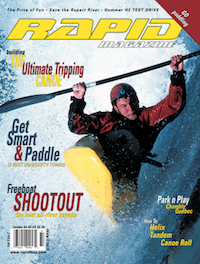The helix is the latest move on the pallete of freestyle paddlers. This new move is a 180-degree upside down flat-spin that resembles the rotation of a helicopter rotor. That’s right, it is not a 360 rotation as most people think. The helix is just a bounce and an elaborate roll like the donkey flip, roll-X or the pan am. The boat slides sideways down the face of a wave and when the upstream edge pops up in the air, the stern gets pushed, upside down, toward where the bow just was. The move, when airborne, is really cool to watch and punishing to learn. The first person to actually land and name the move was Steve Fisher, longtime paddler of the Zambezi River. There were variations of the helix before His Holiness published the name helix on the Internet, but he, unlike everyone else, stomped the landing.
Step 1
Find the top of a nice big green wave face with a big foam pile. The foam pile will help catch you when you inevitably land on your head. Slide down the face of the wave sideways and let the upstream edge drop flat with the face of the wave. When the boat picks up speed, pull up the upstream knee and hop the boat sideways. Be sure to lean your head downstream for the hopping. The idea is to get the boat to hop as high as you can without flipping upstream. Practice this for awhile, the more height the better for the helix. You’ll need to lean a little more upstream for better height but you’ll likely crash a bunch learning.
Step 2
Just as the boat leaves the water for the first bounce, punch the downstream hand and its non-power face forward in a reverse sweep while dropping your head back on the same side. Throwing your head leads the move, and begins the spin movement by pushing the stern upstream and sends the bow downstream. If you don’t push the stern hard enough the edge drops and the cockpit rim is going to catch you in the ribs, and it really smarts.
Step 3
As the boat flips over on top of you, the paddle blade you pushed with will become open to the water upstream. Keeping the pad- dle engaged will swing your legs frighteningly fast over your head. You don’t need to pull on it, but some people do. Try both methods to find out what works best at your play spot.
Step 4
Your body needs to tuck under your boat by pulling your legs on top of you. Think of touching your toes while throwing your legs over your head. Once your legs have swung past your face, the stern will engage and the boat will want to flip back upright.
Step 5
You are now on your other edge and on your other paddle blade. On a big wave this is when you want to low brace. The low brace will, with the energy of the water, flip you right side up. On smaller waves this last part of the helix is a very fast roll. Either way, your automatic response will be a hip flick, so let it happen.
Billy Harris will be teaching intermediate and advanced freestyle clinics for Madawaska Kanu Centre.





